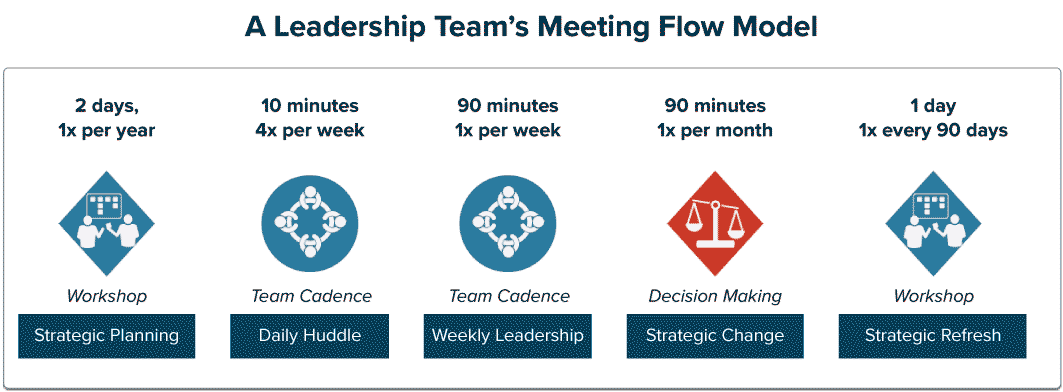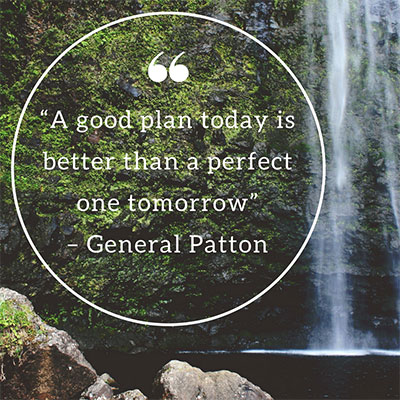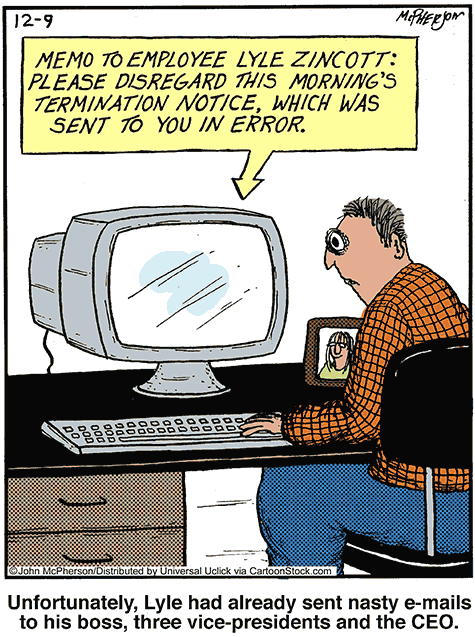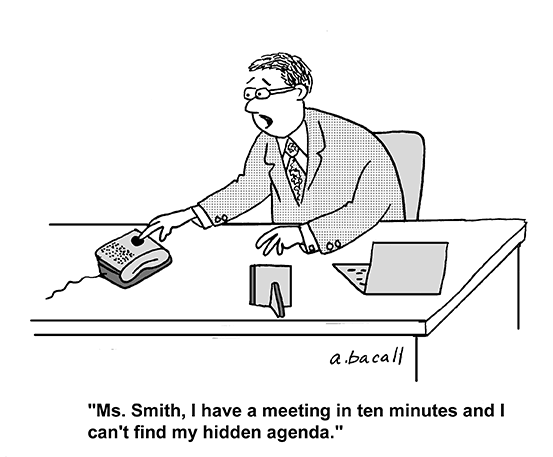How to Create a Useful Meeting Flow Model for Your Team
A Meeting Flow Model is a form of process documentation that highlights the main meetings used to achieve a business result. In the previous article, I introduced the Meeting Flow Model (MFM) concept and described some of the benefits enjoyed by teams that use a defined MFM. Meeting Flow Models are super sweet.
You and your team can get these benefits too, but only after you start using an MFM and then work to refine it for your unique needs.
How do you get a useful Meeting Flow Model for your team?
By doing some Meeting Flow Modeling.
Meeting Flow Modeling is a multi-step process that takes teams several days–and often longer–to complete. In our Quickstart program, we walk teams through this process over the course of several weeks. I’m sharing this in case you think the process below looks a little complicated at first glance. Please keep in mind that this isn’t something you’re going to knock out in an afternoon.
Meeting Flow Modeling is the design of how your team will work together in your part of the business. It’s setting an intention for how you’ll experience your time together. It’s your opportunity to optimize your meetings to drive your team’s performance, imbue work with your core values, and solidify your team’s reputation.
Meeting Flow Modeling is a big deal. How can you get started?
Two Ways to Get Started
We’ve found that there are two approaches that work best.
- Adopt an existing Meeting Flow Model, then tweak it.
- Draft a new Meeting Flow Model from scratch, then prioritize the design of your most critical meetings.
Adopting an Existing MFM
Starting with an existing MFM is obviously easier and faster, so if you can find one that’s designed to achieve the same kind of goals you’re trying to achieve, use it as a starting place.
Our article and guidebook describing The 4 Meetings That Drive Strategic Execution gives you one example. You can find others embedded in several business methodologies (although they don’t use the MFM term), including:
- Agile development: Scrum, SAFE, etc.
- Business operating systems: EOS (Entrepreneur’s Operating System), Gazelle’s Scale Up, Teal, Holocracy, etc.
- Governance groups and committee-based standards development
- Sales systems
- and more.
At Lucid, we’re working to identify and publish as many useful Meeting Flow Models as we can, so stay tuned for more detailed great examples.
That said, even if you start with a fully baked MFM, you’ll probably want to adapt it for your team. Read through the next sections on creating your model from scratch to see some of the ways you might do that.
Creating a New Meeting Flow Model
We walk teams through a way to rapidly design an initial MFM together in our Quickstart. At the end of the initial workshop, each team walks out with a basic MFM for one of their business processes and a target meeting that they’ll work to improve.
Here’s an overview of how we get to that point.
Step-by Step Instructions
- Agree on the business process you’re designing.
- Create a flowchart showing all the meetings in the process.
In our workshops, we use sticky notes so team members can move the meetings around as they work through the flow. Each flow usually includes both meetings the team currently runs and meetings they believe they should be running. See the next section on “Building Blocks” for guidance. - Evaluate the existing performance of each meeting.
For this step, we ask teams these questions:- In which of these meetings do you feel the most optimistic and engaged?
- Where in the process do things get bogged down?
- Where in the process does it tend to all go wrong?
While some teams struggle with the first question, every team can instantly answer the second two.
- Identify one or two meetings to refine first.
Looking at their draft models and their assessments of how well the process performs today, teams decide on one or two meetings they’ll optimize first.Why just one or two? Because it’s hard to know in advance how many meetings the team will really need. Often when they get those critical meetings right, teams find they need far fewer meetings than they originally thought.
- Run the Meeting Flow Model as a test and refine it.
Every time you develop a new MFM, we recommend treating it as an experiment. Invite your team to test these meetings with you, to take an active role in improving team meetings, and to provide feedback you can all use to improve.
Building Blocks: the Number and Type of Meetings
Let’s back up for a second. Throughout this whole discussion of Meeting Flow Models, I’ve been assuming we’re all agreed on some foundational, building-block concepts. Our research shows that’s not a safe assumption, though, so let’s quickly revisit those concepts here.
Concept 1: Why We Need Meetings
An MFM is one component of a larger business process. A great MFM will include the minimal number of meetings required to support the larger value stream.
Which raises the question: at what point in any given process do you need to meet? Really, why do we need to meet at all?
It helps to remember the business function of a successful meeting.
Teams use meetings to:
- Create shared perspective.
Aha! It’s an elephant. - Secure alignment and commitment to act.
It’s an elephant. Let’s take it to the forest! - Inject energy, enthusiasm, and momentum into their work.
Woohoo, yeah! Let’s do this!
I covered all this in my book and in this article, which explains why we meet (including the elephant references) in detail.
This makes meetings useful at any point in the process when:
- Those involved lack a shared perspective on the work.
- Those involved aren’t working towards a common goal.
- You’re losing momentum.
The result? Teams don’t have just one meeting and call it good. Active teams have lots of meetings to create that perspective, ensure alignment, and maintain momentum.
To put this in research-backed language, you’ll often encounter those challenges any time there is:
- High interdependence between the people involved,
- Significant complexity,
- Frequent change,
- and/or a lack of predictability,
then you’ll want to meet.
And on the flip side, you DO NOT need meetings when:
- Everyone already understands what’s going on and what they’re supposed to do (or they can figure it out super easy on their own).
- Everyone is making adequate progress.
- Everyone still cares enough to keep on keeping on.
Concept 2: There are 16 different types of useful meetings.
It’s not useful to just get everyone in a room to “talk about work.” We need to have different kinds of conversations at each point in the process.
We’ve identified 16 key meeting types that work really well.
What does this mean for your Meeting Flow Model? It means you’ll want to replace those generic “meeting” dots with the specific type of meeting needed at each point in the work.

Your model will most likely require:
- Several meetings at the beginning of the process, to get everyone up-to-speed, aligned, and out of the starting gate.
Introductions, Sensemaking, Workshops, Idea Generation, Planning, and Decision Making - Regular, short meetings while the work is in progress to maintain momentum and alignment.
Team Cadence, Progress Checks, One-on-Ones, Governance Cadence - Meetings any time there is a major hand-off between groups or when new folks join the team to clue them in.
Training, Introductions, Sensemaking, Planning - Meetings to learn, refine, double-check and course-correct.
Action Reviews, Problem Solving, Planning, Sensemaking, Decision Making
How many is “several”? What’s the distinction between “regular” and “periodic”? This completely depends on your team and your work. Figuring this out for everyone is a huge part of designing an MFM that unlocks your team’s best performance.
So when you’ve got your Meeting Flow Model written up, what should it include?
The Anatomy of a Great Meeting Flow Model
Quick note: Don’t let this list intimidate you. ANY guidance about how and when your team should meet is better than nothing.
A fully mature Meeting Flow Model will include the following information.
Name and Description
This tells new people what process this MFM supports and when they should use it.
Intent
This explains what the MFM is meant to help a team achieve. For example, the intent for a sales MFM might be to convert a prospect into a high-value, happy customer as quickly as possible.
For our models, we’ve found it useful to also include high-level Guidance (values or Northstar principles to keep in mind) and Anticipated Challenges.
Why? In reality, very few teams follow their MFMs 100% of the time. This section gives them guidance on what matters most and how they should be ready to flex, which becomes useful when they find they need to improvise.
The Players
Describe the different roles people will hold in these meetings. For an internal MFM like the leadership meetings, the players will include the executive leadership team and the occasional guest.
For a major client project, on the other hand, you may have meetings with multiple client stakeholder groups.
Meeting Flows
This is where the flowchart comes in. In our MFMs, we pair each section of the MFM flowchart with a table listing details about each meeting. Here’s an example based on those leadership meetings.

| Type | Meeting | When |
|---|---|---|
| Meetings to set and make changes to the strategy | ||
| WORKSHOP | Annual Strategic Planning Sets strategy and 90-day measurable goals |
2 days, October |
| WORKSHOP | Quarterly Strategic Refresh Adjusts strategy and sets new 90-day goals |
1 day, Jan, Mar, June |
| DECISION MAKING | Strategic Update Decision Making Gets big decisions made using a high-quality decision-making approach |
90+ min, every 3rd Thurs |
| Meetings to manage execution on the strategy | ||
| TEAM CADENCE | Daily Huddle Keeps everyone informed and coordinated, highlights emerging problems fast |
10 min, 8am M, W, TH, F |
| TEAM CADENCE | Weekly Leadership Meeting Checks progress on goals and solves operational challenges |
90 min, 8am Tuesday |
Meeting Templates
Meeting templates tell the team how to run each of the meetings in the flow.
In our practice, we’ve found that high-stakes meetings really benefit from a detailed meeting template. We absolutely want a template for every Workshop. Introductions, Issue Negotiation, Problem Solving, and Decision Making meetings benefit from more up-front design work too.
Other meetings, like Progress Checks and One-on-Ones, often work fine when they stick to the basic best practices for those types of meetings. You can see lots of example meeting templates in our template library.
Related Communications Systems
Finally, list the other communication systems used to support this process. Where do team members find the reports they’ll review in meetings? Where do they publish their meeting records? How are you all communicating status and schedule information between meetings?
These systems may have their own documentation and processes. You don’t need to repeat it all here; just make sure to include some references about how the work teams review and create in meetings gets incorporated back into the business.
In the next article, I share the MFM we’ve designed for running our Enterprise Software Pilot programs as an example. You can see how we document the model, some of the decisions we were able to make once we started working on the model, and how we use it to refine our programs going forward.
So when do you get the cheese?
Once you’ve identified an MFM your team can use, how long will it take to see the benefits?
It takes time to establish new habits and develop new skills. Meeting success will not come automatically; what worthwhile capability ever does?
We don’t have a ton of hard data on this one yet, but I can share what we’re seeing in practice and what we’ve heard from others. Again – this is early. Your mileage will vary.
Teams that work with an outside expert report initial results within 3 months and a significant performance change within 6 to 18 months.
Initial results come from the quick-win changes: cancelling useless meetings, getting clear on meeting purpose, or establishing a really good weekly team meeting practice (for example). These initial results make meetings way better.
The bigger performance boosts come after several months of practice and refinement with the new systems. These performance boosts make the whole business better. We help teams get these results through our Quickstart program. The business consultants and coaches introducing industry standard models (EOS, Agile, Teal, etc), report similar adoption periods.
If your team doesn’t operate in a wildly unique way, working with an expert or starting with an established MFM will get you results much, much faster.
Teams that develop their own models from scratch (without assistance from an outside coach nor the benefit of a reference model) report initial results in one year and significant performance gains within three years. Cisco’s awesome success with One-on-Ones, General McCrystal’s revolutionary daily Operations & Intelligence (O&I) meeting during the Iraq war, and other innovations come from teams developing their practice from first principles – and that just takes longer.
While many of us are working on new products and new business models, we rarely need to invent fundamentally new ways of collaborating. Our recommendation is to always start with an established MFM or the help of an expert when you can, then save your innovative energy for turning that initial model into something brilliantly, uniquely your own.
Next Up
The leadership Meeting Flow Model I’ve shared gives you a simple example. In the next article, you can see an example MFM we developed to support one of our more complex service offerings. That will give you a sense of how far you could go.
Finally, we’ll take a look at how teams at Coda meet. Coda’s simple core MFM provides a great case study for exploring how Meeting Flow Models work as one part of an organization’s larger Meeting Operating System and as the core pillar in your overall communication architecture.



